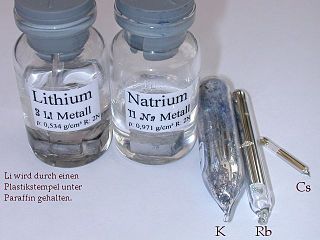Alkali metal
group of chemical elements From Wikipedia, the free encyclopedia
Alkali metals are the chemical elements in group 1 of the periodic table. They are silver-coloured when pure, soft and have only one valence electron. They like to make reactions in which they give up this single electron and then have a charge of +1. They react strongly with water and because of this, they have to be stored in oil. Alkali metals are the first group in the periodic table. They are never found in nature uncombined because they are unstable and they react fast to other elements. They bond well with all elements except the noble gases. When they are in air, they quickly turn black.
The alkali metals are lithium (Li), sodium (Na), potassium (K), rubidium (Rb), caesium (sometimes written cesium, although caesium is preferred) (Cs), and francium (Fr). Lithium is the least reactive. Although it was thought before that francium would be the most reactive, though it is very rare, it was more recently predicted that caesium is in fact more reactive than francium due to relativity.
Lithium Is a very light metal. It is soft, silver and you can cut it with a knife.
Sodium is the most important alkali metal. One of the most important salts of sodium is sodium chloride (NaCl) (common 'table salt'). It also forms a hydroxide, sodium hydroxide (NaOH), which is commonly called 'caustic soda'. It is a very strong base.

Potassium is commonly found in bananas.
Rubidium is a metal that can make things like fireworks red.
Caesium is a very heavy, poisonous metal and is the most reactive metal.
Francium is a very dangerous, radioactive metal. Not much is known about it.
Wikiwand - on
Seamless Wikipedia browsing. On steroids.
